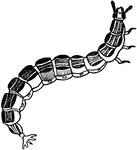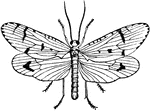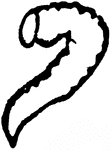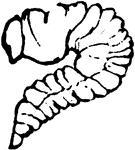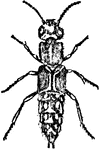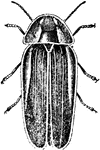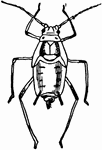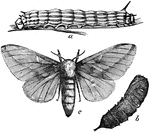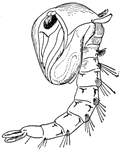
Fish-Killing Buffalo Gnat Larva
"They are small hump-backed gnats, of a gray or blackish color, with broad pale wings." —Whitney,…

Flea Larva
An illustration of the larva of a common flea. Flea larvae emerge from the eggs to feed on any available…
Robber Fly Larva
The larva of Efferia aestuans (or Erax bastardi), an insect in the Asilidae family of robber flies.

Botfly Larva
"After attaching themselves to the walls of the stomach, the botfly larva are nourished by the blood…
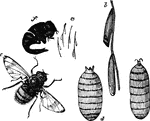
Breeze Fly
"a, eggs of the Breeze-fly; b, the same magnified; c, larva, or bot; d, chrysalis; e, perfect insect;…
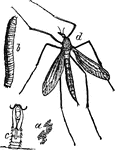
Crane Fly
"Crane-fly (Tipula oleracea): a, eggs; b, larva; c, pupa case as left by the insect, sticking out of…

Sarracenia Flesh Fly
"Sarracenia Flesh-fly (Sarcophaga sarraceniae). a, larva; b, pupa; c, fly; d, head and prothoracic joints…
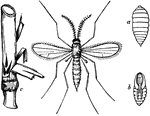
Stages of the Hessian Fly
Now known as Mayetiola destructor: "Hessian Fly (Cecidomyia destructor). a, larva; b, pupa; c, infested…

Larva, Frothy Section, and Perfect Insect of the Frog Hopper
Frog hoppers belong to the order Heteroptera. This order is also known as plant bugs. These insects…
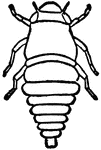
Larval Frog Hopper
"Frog Hoppers are ranked under the homopterous sub-order of insects. The name of frog hopper refers…

Larva, Frothy Secretion, and Perfect Insect of the Frog Hopper
Frog hopper belong to the same order as aphidoe, to the section which has the leathery upper wings.…
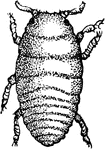
Grape Gall Louse Larva
"Grape Gall-louse (Phylloxera vastatrix), the small figures showing natural sizes. Larva as it appears…
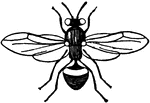
Gall-fly
Gall-fly is a name applied to the members of the family Cynipidae, which are not flies, but are related…

Geometrina
"The Geometrina in the larval condition have only four prolegs, the usual number being ten, and in moving…

Geometrina
"The Geometrina in the larval condition have only four prolegs, the usual number being ten, and in moving…
Buffalo Gnat Larva
The larva is curious little creatures, living under water in rather swiftly flowing streams, clinging…
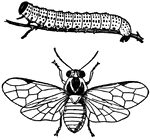
Gooseberry Caterpillar (Nematus ribesii) and Sawfly
Gooseberry Caterpillar is the name applied to the larvæ of two different insects, both injurious to…
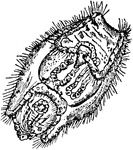
Holothuria Tubulosa (Larva)
An illustration of the larval form of the Holothuria tubulosa, sea cucumber.
Insect Life Stages
Illustrated are the four stages in an insects' life: egg, larva, pupa, imago. The insect pictured is…

Larva of a Ladybird
Ladybirds and their larva are beneficial to gardens because they eat other insects as food.
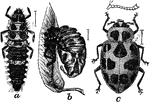
Spotted Ladybird
Also known as megilla maculata. A-Larva; B-Empty skin; C-Beetle with enlarged antenna above.

Larva
The larva of a weevil. A larva is a juvenile form of animal with indirect development, undergoing metamorphosis.
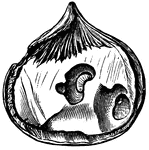
Larva in Chestnut
The larva of a weevil in a chestnut. A larva is a juvenile form of animal with indirect development,…

Larva of Goat Moth
Goat moth caterpillars are destructive to timber and fruit trees. When fully grown the caterpillar is…
Mealworm Larva
Mealworms are the larva form of the mealworm beetle, Tenebrio molitor, a species of darkling beetle.…
Caterpillar of the Leopard Moth
The larva, or caterpillar, of the leopard moth is whitish with black glossy spots. The caterpillar has…
Larva of a Leopard Moth
Larva are unlike the mature insect. Larva of the moth or butterfly resemble worms. It may have a distinct…
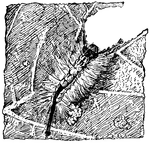
Tussock Moth Larva
The larva of the tussock moth bear several pencils of long black hairs placed at each end. The larva…
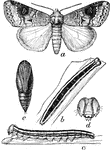
Moth Stages
"Mamestra legitima: a, adult; b, larva from above; c, same from side; d, head of same from front; e,…
Larva of Cecropia Moth
An illustration of the larva of a ceropia moth. The cecropia moth is one of the largest moths found…
